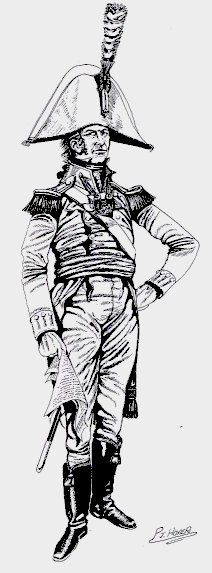|
One of the more interesting facets of the uniform was, without doubt, the most unusual belt plate, being in the shape of a gorget, with the Arabic '10' within a ring, being domed high where the number was pinned on, the plate being completely silver. This plate was certainly unique, and identified the regiment immediately. The shoulder belt was white, passing over the right shoulder under the epaulette.The sash was crimson silk, worn over the coat and shoulder belt, knotted on the left side and sized to pass three times around the body. Waistcoat and breeches were of white cloth, the former being quite plain, and without skirts or pocket flaps; the buttons were small and similar to those on the coat. Boots trimmed with silver lace and tassels seem to have been 'a la mode', and can clearly be seen in a number of illustrations. At this time, battalion officers were armed with the Infantry Officers' Pattern 1796 sword, which was a development of the 1786 Pattern. The blade was 32 inches long and 1 inch wide - both patterns being identical - the only change being to the hilt. However, the hilt of the 1796 Pattern was clearly defined in the General Order dated 4th May 1796, which stated, among other things, "The sword, to have a brass guard, pommel and shell, gilt with gold; with the gripe, or handle, of silver twisted wire." The order continues, The blades were often blued and gilded or decorated with engraving. The scabbard was of black leather with brass locket, band and chape. Regardless of regulations, flank company officers appear to have forged their own way, and many carried sabres, which were officially recognised in 1799. |
|
|
FOOTNOTES: 1. I have recently seen a photograph of the original Loftie watercolour, which is in the Biblioteque Nationale, Paris. Allowing for those hidden behind belt and sash, there would appear to be twelve buttons on each lapel, and one on either side of the collar. The buttonholes are plain with twist finish, and the coat is trimmed with white piping down the front, around the top of the collar, and along the edge of the pocket flaps, which are horizontal, each having four buttons. The turnbacks are white and trimmed with lace, presumably silver. The unusual belt plate, as previously described, is again in evidence. The figure wears black knee length boots without lacing or tassels. His headdress is the large bicorne hat with white over red feather. 2. Most of the contemporary portraits show the conventional epaulette which was silver with fringes, the strap having an edging of yellow cloth and a blue stripe. It is interesting to note that in Goetz's pattern book of (approximately) the period concerned, a metal plate is depicted, and described thus: "10 Epaulet, all silver boild Dead and Burnish'd the number left
Dead, thickefs of silver No.4 in the Gaudges. The design in the middle of the plate is reproduced exactly on the the epaulette strap. The light company wing was probably typical of the period. The exact
pattern is unknown. Goetz records a metal one, but does not state the
regiment. This could also be possibly for the 10th Foot. It is described
thus: |

|
|
REFERENCES CONSULTED: ~History of The Tenth Foot - Lee |
|